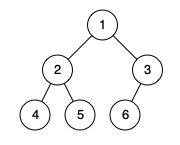Depth First Search Algorithm to Find Leaves of a Binary Tree
- 时间:2020-09-26 22:11:41
- 分类:网络文摘
- 阅读:125 次
Given a binary tree, collect a tree’s nodes as if you were doing this: Collect and remove all leaves, repeat until the tree is empty.
Example:
Input: [1,2,3,4,5]1 / \ 2 3 / \ 4 5Output: [[4,5,3],[2],[1]]
Example of a Complete Binary Tree
Explanation:
1. Removing the leaves [4,5,3] would result in this tree:1 / 22. Now removing the leaf [2] would result in this tree:
13. Now removing the leaf [1] would result in the empty tree:
[]
Finding the leaves is easy, but it is not trivial to remove them and iteratively finding new leaves until the tree is empty. We may however simulate the process, which takes time and this requires somehow a complex piece of implementation.
Depth First Search Algorithm to Find the Binary Tree Leaves
We define a function that recursively computes the distances/depth between any nodes to the leaf nodes. Then we can associate the nodes with its depth. This will be implemented using recursion and the following Java code demonstrates the Depth First Search.
1 2 3 4 5 6 7 8 9 10 11 12 13 14 15 16 17 18 19 20 21 22 23 24 25 26 27 | /** * Definition for a binary tree node. * public class TreeNode { * int val; * TreeNode left; * TreeNode right; * TreeNode(int x) { val = x; } * } */ class Solution { public List<List<Integer>> findLeaves(TreeNode root) { List<List<Integer>> r = new ArrayList<List<Integer>>(); dfs(root, r); return r; } private int dfs(TreeNode root, List<List<Integer>> r) { if (root == null) return 0; // leave nodes are depth 0. // the depth is the max between two branches + 1 int h = Math.max(dfs(root.left, r), dfs(root.right, r)) + 1; if (r.size() < h) { r.add(new ArrayList<Integer>()); } r.get(h - 1).add(root.val); // put the 'leave' to its level return h; } } |
/**
* Definition for a binary tree node.
* public class TreeNode {
* int val;
* TreeNode left;
* TreeNode right;
* TreeNode(int x) { val = x; }
* }
*/
class Solution {
public List<List<Integer>> findLeaves(TreeNode root) {
List<List<Integer>> r = new ArrayList<List<Integer>>();
dfs(root, r);
return r;
}
private int dfs(TreeNode root, List<List<Integer>> r) {
if (root == null) return 0; // leave nodes are depth 0.
// the depth is the max between two branches + 1
int h = Math.max(dfs(root.left, r), dfs(root.right, r)) + 1;
if (r.size() < h) {
r.add(new ArrayList<Integer>());
}
r.get(h - 1).add(root.val); // put the 'leave' to its level
return h;
}
}The DFS runs at O(N) time where N is the number of the nodes in the given binary tree. The space complexity is O(N) as well. The following is the C++ implementation of the same algorithm (so the time and space complexity is the same – O(N)).
1 2 3 4 5 6 7 8 9 10 11 12 13 14 15 16 17 18 19 20 21 22 23 24 25 26 27 28 29 30 31 | /** * Definition for a binary tree node. * struct TreeNode { * int val; * TreeNode *left; * TreeNode *right; * TreeNode(int x) : val(x), left(NULL), right(NULL) {} * }; */ class Solution { public: vector<vector<int>> findLeaves(TreeNode* root) { vector<vector<int>> res; dfs(root, res); return res; } int dfs(TreeNode* root, vector<vector<int>> &r) { if (root == NULL) { // leave nodes are depth 0. return 0; } int lv = dfs(root->left, r); int rv = dfs(root->right, r); int h = 1 + max(lv, rv); if (h > r.size()) { r.push_back({}); // allocate for the new level } r[h - 1].push_back(root->val); return h; } }; |
/**
* Definition for a binary tree node.
* struct TreeNode {
* int val;
* TreeNode *left;
* TreeNode *right;
* TreeNode(int x) : val(x), left(NULL), right(NULL) {}
* };
*/
class Solution {
public:
vector<vector<int>> findLeaves(TreeNode* root) {
vector<vector<int>> res;
dfs(root, res);
return res;
}
int dfs(TreeNode* root, vector<vector<int>> &r) {
if (root == NULL) { // leave nodes are depth 0.
return 0;
}
int lv = dfs(root->left, r);
int rv = dfs(root->right, r);
int h = 1 + max(lv, rv);
if (h > r.size()) {
r.push_back({}); // allocate for the new level
}
r[h - 1].push_back(root->val);
return h;
}
};The Depth First Search Algorithm is usually implemented using Recursion where a stack will be generated and maintained by the compiler automatically. You could, however, convert the recursion into the iterative approach by manually operating the stack.
–EOF (The Ultimate Computing & Technology Blog) —
推荐阅读:数学题-有两棵古柏树 关于连减的简便计算的几种题型 数学题——一种余数相同的问题 周末妈妈从家送巧巧去学校学钢琴 平角就是一条直线判断对错 29957四舍五入到百位、千位、万位是多少? 已知被除数,除数,商与余数的和是235,已知商是27,余数是6,求除数。 图中几条直线、几条射线、几条线段? 滞尘是什么意思? 冬冬是2008年2月29日出生的,到2016年2月29日他一共过了几个生日?
- 评论列表
-
- 添加评论
